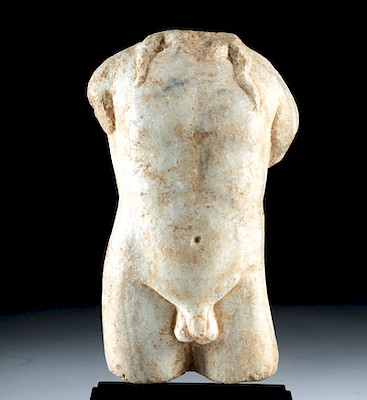Roman Marble Sarcophagus Relief - Cupid
Lot 57b
About Seller
Artemis Fine Arts
686 S Taylor Ave, Ste 106
Louisville, CO 80027
United States
Selling antiquities, ancient and ethnographic art online since 1993, Artemis Gallery specializes in Classical Antiquities (Egyptian, Greek, Roman, Near Eastern), Asian, Pre-Columbian, African / Tribal / Oceanographic art. Our extensive inventory includes pottery, stone, metal, wood, glass and textil...Read more
Estimate:
$2,000 - $3,000
Absentee vs Live bid
Two ways to bid:
- Leave a max absentee bid and the platform will bid on your behalf up to your maximum bid during the live auction.
- Bid live during the auction and your bids will be submitted real-time to the auctioneer.
Bid Increments
| Price | Bid Increment |
|---|---|
| $0 | $25 |
| $300 | $50 |
| $1,000 | $100 |
| $2,000 | $250 |
| $5,000 | $500 |
| $10,000 | $1,000 |
| $20,000 | $2,500 |
| $50,000 | $5,000 |
| $100,000 | $10,000 |
| $200,000 | $20,000 |
About Auction
By Artemis Fine Arts
Dec 5, 2018
Set Reminder
2018-12-05 10:00:00
2018-12-05 10:00:00
America/New_York
Bidsquare
Bidsquare : DAY 1 | Classical Antiquities & Asian Art
https://www.bidsquare.com/auctions/artemis-gallery/day-1-classical-antiquities-asian-art-3698
Day 1 of an important 2-day auction featuring ancient and ethnographic art from around the world. Egyptian, Greek, Roman, Viking, Near Eastern plus Asian Art from China, Japan, Thailand, Vietnam, Burma, India, more. Artemis Fine Arts info@artemisfinearts.com
Day 1 of an important 2-day auction featuring ancient and ethnographic art from around the world. Egyptian, Greek, Roman, Viking, Near Eastern plus Asian Art from China, Japan, Thailand, Vietnam, Burma, India, more. Artemis Fine Arts info@artemisfinearts.com
- Lot Description
Roman, Imperial Period, ca. 3rd century CE. Finely carved in low to high relief - a section of a marble sarcophagus - the upper border suggesting it was part of the upper frieze of a sarcophagus - depicting a winged cherub, perhaps Cupid (Eros), with finely delineated feathery wings and a cherubic visage facing right. In addition to possessing an impressive ability to render flesh from stone, the sculptor of this piece was skilled in communicating naturalism in Cupid's facial features - generously lidded, almond-shaped eyes, apple cheeks, parted lips, and that fleshy nose - framed by a wavy coiffure with curly locks. Eros has a generous fold of drapery on his left shoulder, and behind is his incised and drilled wing. Size: 8.75" W x 8" H (22.2 cm x 20.3 cm); 9.375" H (23.8 cm) on included custom stand.
Cupid or Eros was the mischievous yet endearing god of love, a minion, constant companion, and according to some classical writers, a son of the goddess Venus/Aphrodite. In the Roman period, Cupid had become a child, whereas to the earlier Greeks, Eros was a muscular youth. In time, ancient poets and artists multiplied Eros into a group of Erotes - winged gods of love or Roman Cupides. Hesiod describes a pair - Eros (Love) and Himeros (Desire) - both present at the birth of Aphrodite. However, later writers added a third Erote named Pothos (Passion). Some depicted twin Erotes - Eros (Love) and Anteros (Love Reciprocated) - who were usually shown gracing the scales of love. Eventually, poets multiplied them to envision an even greater number of winged putti. Indeed, the Erotes were the creations of poetic invention without any distinct mythology of their own - as opposed to Cupid/Eros, the God of Love.
Sarcophagi became more popular at the beginning of the 2nd century CE when burial grew more favorable than cremation. Carved from stone, in this case marble, the panels were adorned with high and low relief mythological scenes, and by the 2nd century, it was also common to include a portrait of the deceased in a heroic guise. This section features Cupid as symbolic of love in the hereafter. A rare and beauteous piece from ancient Rome!
Cf: the lid of a wine-making sarcophagus in Rome, illustrated in Guntram Koch & Hellmut Sichtermann, Roemische Sarkophage (Munich, 1982), fig. 252; a season sarcophagus in the Vatican, illustrated in Guntram Koch, "Ein dekorativer Sarkophag mit Scherengitter in der Henry E. Huntington Library and Art Gallery, San Marino, "Roman Funerary Monuments in the J. Paul Getty Museum 1 (1990) (Occasional Papers on Antiquities, 6), fig. 91, p. 67; a Cupid and Psyche sarcophagus in London, published in Susan Walker, Catalogue of Roman Sarcophagi in the British Museum (London, 1990), cat. No. 30, p. 31, pl. 11.
Provenance: private East Coast, USA collection; Arte Primitivo 41 (April 23, 2007 - lot 200)
All items legal to buy/sell under U.S. Statute covering cultural patrimony Code 2600, CHAPTER 14, and are guaranteed to be as described or your money back.
A Certificate of Authenticity will accompany all winning bids.
We ship worldwide and handle all shipping in-house for your convenience.
#136977A section from a larger sarcophagus. Losses/abrasions/nicks to edges and high pointed areas as shown. Traces of white and red paint on the peripheries and nose. Earthen encrustations.Condition
- Shipping Info
-
All shipping is handled in-house for your convenience. Your invoice from Artemis Gallery will include shipping calculation instructions. If in doubt, please inquire BEFORE bidding for estimated shipping costs for individual items.
-
- Buyer's Premium



 EUR
EUR CAD
CAD AUD
AUD GBP
GBP MXN
MXN HKD
HKD CNY
CNY MYR
MYR SEK
SEK SGD
SGD CHF
CHF THB
THB














